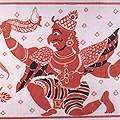In the ancient times, painters and designers created a range of forms and designs on cloth for religious and national ceremonies. Religious paintings on cloth were known as petikada; the inspiration behind them ranged from painted ceilings to the walls of temples. Preserved specimens of cloth paintings indicate the use of bright colours – red, yellow, and white. The topics selected are presented in a continuous narrative form resembling mural paintings.
CLOTH PAINTINGS
Cloth painting was an art practised widely by the temple painters of Kandy, the central province of Sri Lanka, as well as in the Low Country. These painters, superb craftsmen – were devout Buddhists who expressed their beliefs and feelings on cloth. The themes selected were the Jataka tales, and the execution depicted balance and symmetry of figures in the composition and a lively sense of colour. Along with such cloth paintings, banners and pennants added to the grandeur at state occasions and pageants.
FLAGS
Flags – highlighting national and regional identities – were also widely displayed during festivities. The district and korale flags had figures of totemistic animals on them, lions, peacocks, elephants, and swans being common. The national symbols on the flags were always very meticulously executed.
Flags and banners also serve as historical records of various events over the ages. Administrative departments, high-ranking officials, and temples had their own flags, all fine specimens of craftsmanship. Some examples of significant flags and banners are: the flag of the Salagama weavers which shows the origin of the community; the banner of the Karava caste displaying the mythical makara or sea-monster; and the hanumanta flag of the Navandanna caste, which highlights an event in Sri Lanka’s pre-history involving God Visvakarma and Hanuman and also exhibits the tools used by craftsmen then. All these are of immense artistic and historical value.
Suitable flags were carried in royal or religious processions held in the various regions as also for the annual Perahera in which the sacred Tooth Relic at the Temple of the Tooth Relic at Kandy is carried out in a procession. The materials used for the flags were cotton as well as silk; the flags were painted or dyed to convey the historical or cultural significance of an event.
Flags represent a significant folk tradition of painting that highlights the sense of colour and design possessed by the artists in harmonising motifs and symbols into a composition. Today flags are used by the artists to depict a contemporary event visually and symbolise a concept. This evokes feelings of solidarity, unity, and national consciousness along with a decorative appeal as a work of art.
Flags are adapted and used as background décor for exhibitions and trade fairs giving the painters a chance to display their artistry and flair. Sometimes batik craft is also used by the artists to make attractive flags using traditional motifs and indigenous patterns.
Gallery
YOUR VIEWS
PRACTITIONERS: INDIA
Access 70,000+ practitioners in 2500+ crafts across India.
BIBLIOGRAPHY
10,000+ listings on arts, crafts, design, heritage, culture etc.
GLOSSARY
Rich and often unfamiliar vocabulary of crafts and textiles.
SHOP at India InCH
Needs to be written.






